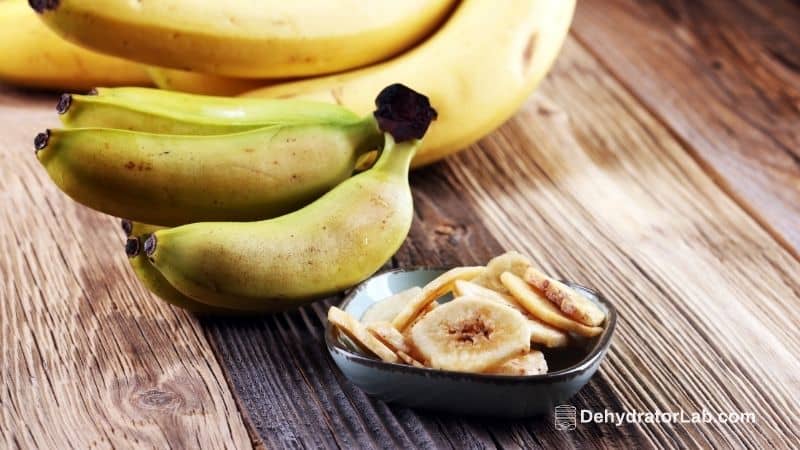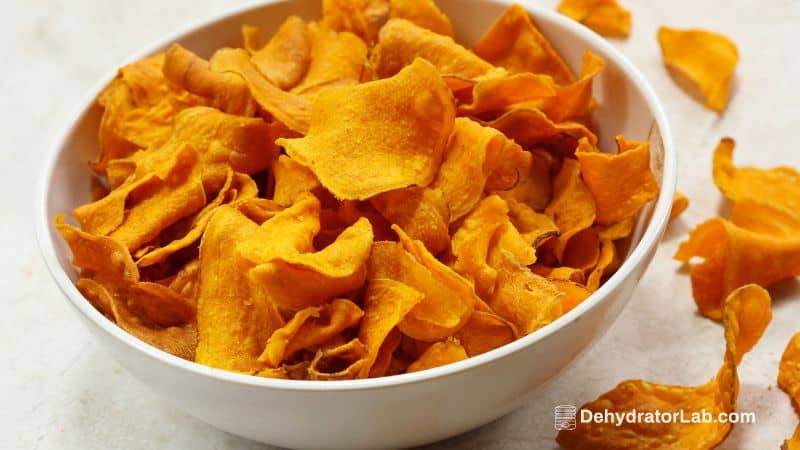Dehydrated banana chips are the best. Crunchy and crispy, sweet in the same time. Read on and learn a few recipes and methods of how to dehydrate bananas using a dehydrator or a microwave or an oven or simply just the sun. But first, let’s see why bananas are so good for you?
In this article:
Why Are Bananas Good for You?
I bet we all love bananas (at least most of us). This fruit has been a staple for most families across the world from as early as 500BC. Ripe or unripe bananas have both curative and preventative properties that everyone should take advantage of. They have high antioxidant properties and are rich in potassium, fiber, vitamins C and B6, and magnesium.
Bananas also have anti-inflammatory properties that reduce swelling. Research has also shown that eating bananas prevents against developing type-2 diabetes, strengthens the nervous system, assist in the manufacture of white blood cells as well as assist with weight loss.

The nutritional value of bananas increases as they continue to ripen. This is why the nutrients have to be preserved to stay for a longer time for the user to get maximum benefits.
How Do You Take Your Bananas?
There are very many ways of taking bananas. For instance, they can be consumed as fresh fruits, fruit pudding, blended into some smoothie, or mixed with other fruits. Additionally, bananas can also be consumed as dry fruits after dehydrating for use as a snack.

Dehydrating bananas is the current craze. Dehydrated bananas are simply fantastic and can make several dishes including banana fruit leather, crispy chips, and chewy wedges.
Let’s get into it, how to make you dehydrated banana chips using a dehydrator?
How to Make Banana Chips in Dehydrator

With the availability of so many top of the line dehydrators, making crunchy banana chips with a dehydrator is one of the easiest ways to make those crispy bananas chips, a really healthy snack on-the-go or at home.
We will be discussing how to dehydrate bananas without a dehydrator later in this articles As at this time, here is how you do it with a dehydrator.
Dehydrated Bananas Recipe Using a Dehydrator
Ingredients
- Bananas (as many as you want)
- Freshly squeezed lemon juice (1 cup)
- Water (1 cup)
- A bowl
- Dehydrator
- Mesh rack
- Cookie sheet
- Storage bags
Instructions
- Depending on the number of bananas that you want to dehydrate, mix equal portions of lemon juice and water in a box.
- Unzip the bananas to remove the outer skin.
- Slice them in round chips with considerable thickness. The chips should not be so small because they may stick together. ¼-inch coins are ideal. You are not limited to banana coins though. You can also slice them lengthwise to create varieties.
- Dip the banana chips in lemon juice to prevent browning. Flip them around to ensure that they are evenly coated. At this stage, you can also sprinkle some nutmeg to add some flavor.
- Oil the rack on the dehydrator to prevent the chips from sticking on the rack. Alternatively, you can rub some oil on the banana chips gently.
- Place the chips on the dehydrator’s drying rack and avoid overlapping.
- Turn the dehydrator ON and set the temperature to 52-57 degrees Celsius (125-135 degrees F). Note that the ideal drying temperatures may vary with your dehydrator’s guide. The chips will take 6-12 hours to dry well. You should check the progress every 3 hours and rotate the try to allow all the chips to dry evenly.
- After 12 hours, take a sample and cool it to room temperature then taste whether it’s the desired texture. If satisfied, remove the rest of the chips and cool them to room temperature before consuming. They can also be stored for a longer time and used for snacking. This process should also be followed when dehydrating banana wedges instead of the round chips. However, this procedure may require more time as the wedges bake slowly than the chips.
FAQs & Tips to Make Your Banana Crunchy Chips Even Better
Drying bananas in a dehydrator is super easy and does not require any special skills. However, you could make them even better with the tips below:
How Ripe Should Bananas Be for Dehydrating?
Your bananas should be ripe enough for this process. Leave the overripe ones for smoothies. Yellow bananas with small brown speckles is how ripe bananas should be when selecting them for dehydrating. The user is advised to choose the bananas to be dehydrated carefully.
How Thick Do You Cut Bananas for Dehydrating – Chill Them for Easy Cutting
For easy cutting, because they are ripe, you might want to firm up the bananas by chilling them for an hour or two before slicing. This minimizes mushing and sticking together.
Slice them in round chips with considerable thickness. The chips should not be so small because they may stick together. ¼-inch coins are ideal.
How Long Does It Take to Dehydrate Bananas?
For the best banana chips, it takes about 6-12 hours to dry well. After that time is up, take a sample (take care, it might be hot, cool it to room temperature) then taste whether it’s the desired texture. If satisfied, remove the rest of the chips and cool them to room temperature before consuming.
What Temperature to Dehydrate Bananas?
Set the temperature of the dehydrator to 52-57 degrees Celsius (125-135 degrees F). Note that the ideal drying temperatures may vary depending on the type of your dehydrator.
How To Give Your Banana Crisps Another Flavor?
Your munchies will be good to go without any additional flavor. But it never hurts to be creative and give them a whole new taste. You could make dehydrated banana chips with honey, or you could dip the slices in honey (did you know you can dehydrate even honey?), chopped nuts, chocolate, or even coconut flakes to give them another flavoring.
However, it’s good to know that some of these flavorings might affect the drying time. So, you’ll need to factor that in when drying.
How to Store Dehydrated Banana Chips?
You can choose to store the snacks in resealable bags or glass jars. While the latter are the best for home use, resealable bags come in handy when travelling.
All in all, moisture will be your worst enemy during storage. Right from the preparation, ensure that the storage is clean and moisture-free.
You might want to dry the jars with a clean cloth after cleaning to ensure that they are completely dry. Adding uncooked rice in the jar also helps in absorbing moisture.
How To Make Banana Fruit Leather

Follow these steps to dehydrate bananas with the help of a fruit leather dehydrator:
- Peel the bananas and either slice them in half lengthwise or keep them whole.
- Take the bananas and place them in between two sheets of parchment paper. The bananas should be placed 3 inches apart.
- Use a cutting board to smash the bananas and ensure it is even and consistent. The recommended thickness about 0.3cm.
- Take the parchment paper and place it on the dehydrator rack. Peel off the upper sheet before starting the dehydrating process.
- Set the dehydrator temperature at 57 degrees Celsius (135 degrees Fahrenheit) for 7 hours.
- Make sure to check the progress of the banana leather on the 4th and 6th hour.
- You will know they are ready if they are leathery and not sticky. In case you observe that the bottom is still moist, flip the bananas and allow them to dry on the other side.
- When ready, remove and let them cool and slice them into strips. These can be served or stored in an airtight container to ensure they last for longer.
How To Make Sun Dried Bananas

As I told you before, there are a whole lot of ways to dry your bananas without a dehydrator. As you’ll realize, regardless of the method that you use, the end result and nutritional value remain the same. Only the drying time might vary.
Sun drying bananas is one of the simplest methods of dehydrating bananas especially if you live off the grid. The good thing here is that you don’t need power or any specialized equipment.
All you need is a simple outdoor drying screen. This can be purchased or made from a rectangular frame with a mesh spread across it. Care should be taken to ensure that the mesh chosen is either stainless steel or plastic and should be marked food-safe.
The best results are realized on a hot, dry weather with clear skies and low humidity. The temperature should be at least 90 F/32 degrees Celsius. Drying the bananas through the sun might take up to 7 days. Therefore, it pays to dry a good amount that will take you for a longer time before the need to dry again.
10 Easy Steps To Make Sun Dried Bananas At Home Withtout a Dehydrator
- Select ideally ripe bananas with a few brown speckles.
- Peel the bananas to remove the outer skin.
- Slice the bananas into thin rounds.
- Dip the pieces lemon juice to prevent browning. This is optional if you do not mind the brown color.
- Sprinkle some powdered cinnamon to add some snacking flavor.
- Put the pieces on the mesh of the drying frame in a single layer without overlapping them.
- Cover the banana chips with a netting to keep the insects off as well as dust.
- Place the drying frame in direct sunlight but away from any disturbance and car exhaust. It should also be elevated from the ground at a considerable height.
- During the night the drying frame should be brought indoors to prevent dew from settling on the bananas. The chips should be flipped halfway through the drying period to ensure that drying takes place on both sides.
- On the last day check whether they are dry by cutting or biting some. If completely dry, store them in an airtight container.
How To Make Dehydrated Banana Chips Using A Microwave
There are other ways that you can use to dehydrate bananas without a dehydrator. So, you don’t have to beat yourself so hard if you don’t have a dehydrator at the moment.

Besides warming up your food or boiling a cup of water for your coffee, you could use your microwave to prepare banana crisps or wedges for on-the-go munching.
Yes, you don’t have to invest in a food dehydrator if your budget does not allow it at the moment. This method has its upsides and downsides though. Let’s start with the drawbacks.
The major issue with using a microwave is that most of them have a small footprint and might, therefore, not accommodate a large portion of your sliced bananas. This might be quite inconveniencing if you are drying several bunches of bananas for a group. It shouldn’t be an issue if you are preparing the bananas for one person though.
Secondly, microwaves are not designed for dehydrating foods. Thus, you’ll need to keep checking the bananas to ensure that they don’t get overly dry or burnt.
Even worse, the resultant crisps are only ideal for one-day-use. So, it might not be ideal if you want to dry the bananas for storage. On the upside, a microwave is faster and easy to use too.
Dehydrated Bananas Recipe Using A Microwave
- Choose well ripen bananas but ensure they do not have big dark spots except for small brown speckles.
- Peel the outer skins.
- Slice the bananas in small round chips. Ensure that they are not large for easier drying. Very small chips may burn easily thus they are not recommended.
- Oil the microwave safe plate. If you prefer flavors you can make use of flavored oil, for example, coconut or olive oil
- Place the slices with space in between on the microwave plate. Be careful not to overlap the banana slices.
- Turn the microwave on high for one minute to allow the bananas to release moisture.
- Turn the banana slices over and sprinkle some flavor or spices (optional).
- Take the chips back in the microwave and let them heat for 30 seconds and flip them again. This process should continue until you are satisfied with the way they feel or taste.
- Once they are dry serve them immediately or store in an airtight container.
- While this process of dehydrating bananas is easy, the resultant crispy bananas can only be used within one day.
How To Make Crunchy Dehydrated Banana Chips Using An Oven

The good thing with using an oven to dehydrate bananas is that you have the freedom to make banana chips or wedges.
Unlike using a microwave, an oven allows you to set the required drying temperatures.
Even better, you don’t have to baby sit it since you won’t have to flip the banana coins or wedges frequently.
The best part, however, by dehydrating the bananas crisps in the oven, you can store them for months.
Dehydrated Bananas Recipe Using An Oven
- Peel the bananas and slice them in your desired shape, either in rounds or wedges.
- Dip the sliced bananas in lemon juice to add some flavor and prevent browning of the slices.
- Place the slices on a wire rack that allows the slices to air and helps to drain any moisture. Ensure that the chips or wedges are not placed on top of each other.
- Prepare the baking pan and preheat the oven.
- Sprinkle some sea salt or any other preferred spice to add taste.
- Place the banana slices in a preheated oven. It is advisable to place it in the middle rack for effective heating and also to avoid scorching the chips.
- Close the oven and let them bake to desired crispness. The banana rounds may take up to 3 hours to bake while wedges may take up to 6 hours. The longer the baking time the crispier the bananas will be.
- When dry, remove them and let them cool. Store them in an airtight container.
- These banana chips or wedges can be preserved for several months.
Most ovens, however, come with procedures for various baking items. If your oven has banana procedures, it is also advisable that you use the provided instructions.
Conclusion
The above are some of the methods used to dehydrate bananas. These procedures can be useful especially when the banana supply is high thereby helping you to preserve them for days to come.
Apart from that, dehydrating bananas helps you to get better-snacking ideas for everyone in the family. It also gives you other options of eating bananas. It is also interesting to note that bananas can be rehydrated to make a tasty banana pudding. However, this may lessen the shelf life of the bananas.
Additionally, bananas have overwhelming health benefits that everyone should take advantage of as mentioned earlier. This is why dehydrating bananas is a better idea for everyone.
Using a food dehydrator is hands down, the most effective way of dehydrating bananas. The good thing with these gadgets is that they are engineered purposely for this job. Therefore, unlike using a microwave or oven, there are very minimal chances of messing up your snacks.
Dehydrators are also way affordable today than ever before. So, if you wish to make banana crisps or wedges an everyday thing, investing in a food dehydrator might be a superb idea. If you want to do something else, read our article about the best uses for food dehydrator.
Worth noting is that dehydrators vary in terms of temperature and temperature regulation. I find dehydrators with a built in timer and controllable thermostat the best albeit a little bit pricier. If you prefer this convenience, my other guide of the best Excalibur food dehydrators has several options for you.

![Sweet and Spicy Beef Jerky Recipe for Dehydrator [Korean Style]](https://dehydratorlab.com/wp-content/uploads/2023/08/Sweet-and-Spicy-Beef-Jerky.jpg)

